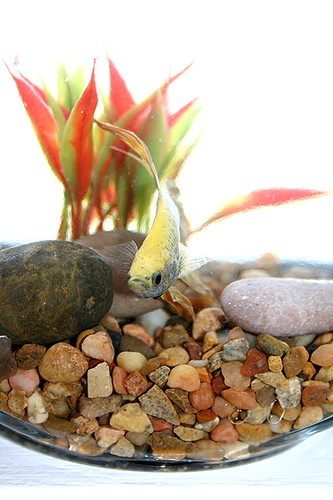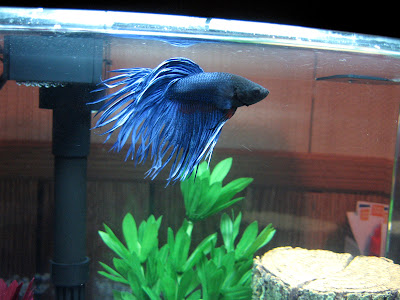DW wrote,
I just wanted to write to you, and say thank you so much for putting up your site! I’ve learned so much from it! I also am in love with the betta photos you put up with each post. Simply amazing. Make me wanna set up my tripod and take a few rolls of my baby with my SLR since my digi doesn’t do him justice!
But now, down to business. I wanted your opinion on how to prevent mini cycles from happening. Yes, yes against what I’ve read, I have been cycling with my precious Gackt (pronounced Gack-tow) in the tank. But I’ve done water checks frequently and changed 25% of the water once a week at least. Also, I was using Splendid Betta water conditioner but changed to Prime which was recommended by a friend.
I was happy because for the past two or three weeks I’ve read 0 anmonia with very low nirite. I just did a water change on either friday or saturday (my memory is grand like that) and when I tested to today it detected anomia. Of course que the freak out from me, so I did another water change.
I am aware of “mini” cycles and know they can happen if you don’t give the bacterica a chance to culture. I’ve had my 3 gal eclipse tank with a bio-wheel for over a month now. I have yet to change the filter and I can’t quite tell if the bio-wheel has a culture growing on it, I check every once in a while to see, thus why I’ve kept the filter in thinking perhaps the bracteria has been culturing on that.
Should I perhaps try seeding with gravel from our 20-some gal fully cycled tank in our living room and help give the bacteria a boost? Any suggestions would be great.
The stats again
3 gallon tank (bio-wheel and filter)
Temp: average 78
Food: Hikari Gold pellets three at a time twice a day
Prime water coniditoner
25% water changes once a week
No meds no salt
Gackt is acting his usual self happily making bubble nests and wiggle dancing when it’s feeding time. Attaching a picture of him for you to see. I just want to prevent the headache of mini cycles. Thanks for your time Christie it means the world to me!
A: Mini-cycles generally occur during the fragile period when the tank is new and happen because of something we do to either remove nitrifying bacterial colonies (like removing the filter media) or by rapidly adding food for the bacteria (like adding additional fish). In a well established tank it’s a lot harder to cause these mini cycles to occur.
In a tank like yours that is newly cycling you may cause mini cycles by changing the filter, aggressively vacuuming the gravel, doing massive water changes or removing fish from the aquarium. Often doing just one of these things aren’t enough to cause a mini cycle but doing a couple in combination certainly could. For instance, removing the filter media and siphoning the gravel may upset the cycle. Doing regular weekly water changes as you have been doing may cause mini cycles too but in this case you are cycling with your fish so these multiple water changes are necessary to keep the fish safe. It sounds like your tank is nearly finished cycling. In the mean time I recommend leaving your filter media in place and only vacuuming a little once a week or every other week until the tank is well established.
The dark material you may be seeing on the bio-wheel, filter bag or gravel is organic material (mulm)and isn’t the bacteria itself, which you can’t see with the naked eye, however, it is likely full of bacteria. The only way to really know if bacteria is present is by measuring it’s byproducts from them (nitrite and nitrate). For nitrite and nitrate to be measurable nitrifying bacteria must be present. When you test your water and see the ammonia and nitrite levels spike and fall and the nitrate begin to rise you then know the bacteria has reproduced fast enough and to large enough colonies to consume the ammonia and nitrite as fast as it’s being made. That is why the ammonia reads 0. The nitrite will read 0 too when the bacterial colonies are as large as they’re going to get and you will see the nitrates then begin to rise. Nitrate is the final byproduct of nitrifying bacteria. If it exists then the bacteria exists.
If you have gravel from an established tank available to you I definitely suggest using it. Adding bacteria from another tank is much faster way to cycle. In many cases you can cut the entire process down to just a few days rather then trying to culture the bacteria practically from scratch, which can take 4 – 6 weeks. If you’ve got it, I say go for it.
Good luck with your new tank and kudos to you for taking the time to learn about the nitrogen cycle.
Image of Gackt provided by DW


My female betta was a brilliant blue yesterday and today I have noticed two white spots on each side of her near the top of her head and her head is solid black now, also noticed some red throughout her fins. Should I be worried?
My tank has 0 ammonia, 5.0 nitrites, and 80 nitrates what should I do